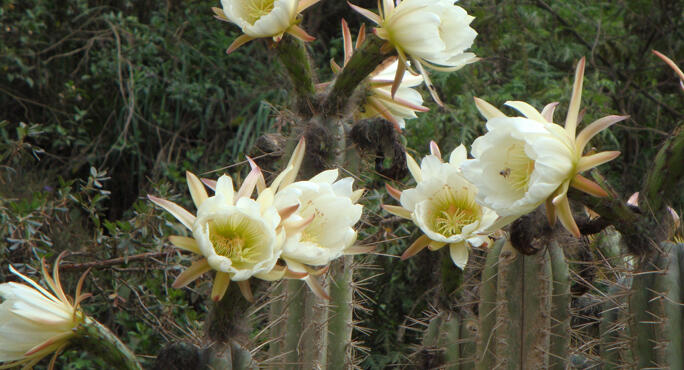
Common Name
Botanical Name
AKA
Don Alejandro the shaman shakes a rattle stick, provoking a sensuous cascade of clicking sounds. He chants softly in the Peruvian night, invoking spirits to assist in healing and enlivening our small group. About twelve of us sit outside on the grass of my friend Sergio’s lawn. In the neighborhood roosters are crowing, and dogs bark next door for a time. Two blocks away, Pacific ocean surf is pounding the beach at Chorillos. Alejandro has a blanket spread out on the grass, festooned with crystals, holy statuary, swords, money, flowers, fruits, and an assortment of magical tools. This is his mesa, a sacred altar set up for ritual healing ceremonies.
After setting a mood for our gathering, don Alejandro picks up several bottles of clear, greenish liquid. The liquid inside the bottles glistens in the night. He hands full bottles to several of us, and advises us to drink. The beverage is San Pedro, Saint Peter’s cactus Tricocereus pachanoi. The name derives from the fact that in Christian mythology Saint Peter holds the keys to heaven, and in the shamanic traditions of the Peruvian Andes, San Pedro cactus is a key to heaven. This popular plant potion is rich in the psychoactive compound mescaline, and in about forty minutes we will be journeying into the spirit world with don Alejandro as our guide.
Alejandro has done this many times before, trained since his early years to be a shaman in the northern Peruvian Chavin tradition, simultaneously a doctor, advisor, and spiritual guide. Most nights he spends performing healing work of all kinds on a steady stream of patients who visit until early in the morning. But this evening Alejandro is performing this ceremony for us, to show us the landscape in which shamans work, and to help us to awaken to greater spiritual awareness.
I open my bottle and drink the fluid. There is a moderate bitterness to it, but not too bad, and I finish off about twelve ounces. So do Sergio and a few others. Then we sit to let the San Pedro begin to work its magic. Known also as the “cactus of the four winds,” San Pedro is one of the most ancient of sacred plants in South America. The oldest known archaeological evidence of its use dates back to 1300 B.C. San Pedro is considered a potent medicine, useful in treating a very broad range of physical, emotional and mental disorders, and with applications for treating addictions.
Throughout history shamans in the Andes have undertaken “journeys” with San Pedro cactus at various sacred lagoons in the high mountains, where this type of cactus grows abundantly. I have personally seen vast quantities of San Pedro cactus growing in the Andes, especially all along the roadsides. There the cactus is also called Huachuma. Since archaic times, people of the region have boiled sliced sections of the long green cactus in water, and have drunk the resulting liquid.
In the famous book on psychoactive plants “Plants of the Gods” the authors offer this quote about San Pedro cactus from a shaman. “the drug produces .. drowsiness or a dreamy state and a feeling of lethargy..a slight dizziness..then a great vision, a clearing of the faculties..It produces a light numbness in the body and afterward a tranquility. And then comes detachment, a type of visual force..inclusive of all the senses..including the sixth sense, the telepathic sense of transmitting oneself across time and matter…like a kind of removal of one’s thought to a distant dimension.”
As don Alejandro shook his rattle stick, I felt myself slipping away, still sitting upright, still perfectly aware of where I was, but also taking off to some distant place at the very same time, as thought swept by an invisible current that pulled me steadily into a realm of vast geometries, of vaulted space filled with light and color and a pervasive sense of being completely connected to all things throughout all time, without beginning or end. I bathed in this experience even as a fine cool mist from the ocean settled in the night air, even as don Alejandro chanted and sprinkled various floral waters, even as my companions laughed and sighed.
Hours later as the effects of the San Pedro waned, I observed that my sight was more clear, and my hearing was more acute. I felt the night air with greater intensity, and I could smell the aroma of salt from the sea. I expected these effects to wear off, but in fact my senses remained more finely tuned for several days. I had the experience of being cleansed, lighter in my body and mind, freed of subtle stress. As it turns out, these are typical and normal experiences resulting from consuming San Pedro cactus, a native Peruvian medicine that enlivens the body, mind and spirit. And while the ritual use of sacred plants such as San Pedro is still marginal in many parts of the world, in some other areas these agents are employed regularly to enhance life.

